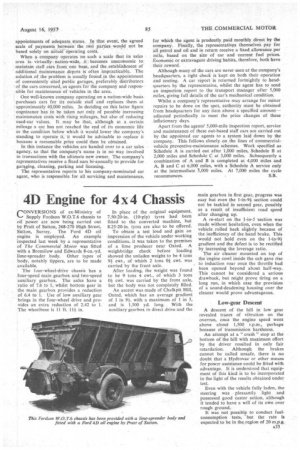4D Engine for 4 x 4 Chassis
Page 59

If you've noticed an error in this article please click here to report it so we can fix it.
CONVERSIONS of ex-Ministry of
Supply Fordson W.O.T.6 chassis to oil power are now being carried out by Pratt of Sutton, 268-270 High Street, Sutton, Surrey. The Ford 4D oil engine is employed. An example inspected last week by a representative of The Commercial Motor was fitted with a Bromilow and Edwards 8-cu.-yd. lime-spreader body. Other types of body, notably tippers, are to be made available.
The four-wheel-drive chassis has a four-speed main gearbox and two-speed auxiliary gearbox. The axles have a ratio of 7.6 to 1, whilst bottom gear in the main gearbox provides a reduction of 6.4 to 1. Use of low auxiliary gear brings in the four-wheel drive and provides an extra reduction of 142 to 1. The wheelbase is 11 ft. 114 in. In place of the original equipment, 7.50-20-in. (10-ply) tyres had been fitted to the converted machine, but 8.25-20-in, tyres are also to be offered. To obtain a test load and gain an impression of the vehicle under working conditions, it was taken to the premises of a lime producer near Oxted. A weighbridge check' before loading showed the unladen weight to be 4 tons 9+ cwt., of which 2 tons 04 cwt. was carried by the front -axle.
After loading, the weight was found to be 9 tons 4 cwt., of which 3 tons 04 cwt. was carried by the front axle, but the body was not completely filled.
An ascent was made of Chalkpit Oxted, which has an average gradient of 1 in 94, with a maximum of 1 in 5, and is 1,500 yd. long. . With the auxiliary gearbox in direct drive and the main gearbox in first gear, progress was easy but even the 1-in-94 section could not he tackled in second gear, possibly as a result of insufficient road speed after changing up.
A re-start on the 1-in-5 -section was made without hesitation, even when the vehicle rolled back slightly because of the inefficiency of the hand brake. This would not hold even on the 1-in-94 gradient and the defect is to he rectified by increasing the leverage ratio.
The air cleaner mounted on top of the engine cowl inside the cab gave rise to induction roar once the throttle had been opened beyond about half-way. This cannot be considered a serious drawback, but might prove tiring on a long run, in which case the provision of a sound-deadening housing over the cleaner would prove advantageous.
Low-gear Descent A descent of the hill in low gear
revealed traces of vibration on the overrun, once the engine speed went above about 1,500 r.p.m., perhaps because of transmission harshness.
An attempt at a " craSh " stop at the bottom of the hill with maximum effort by the driver resulted in only fair retardation. Although the brakes cannot be called unsafe, there is no doubt that a Hydrovac or other means for power assistance could be fitted with advantage. It is understood that equipment of this kind is to be incorporated in the light of the results obtained under test.
Even with the vehicle fully laden, the steering was • pleasantly light and possessed good castor action, although it tended to have a will of its own over rough ground.
It was not possible to conduct fuelconsumption tests, but the rate is expected to be in the region of 20 m.p.g. a33




























































































